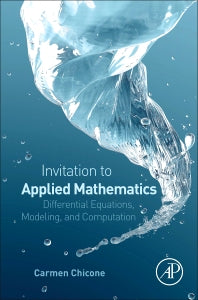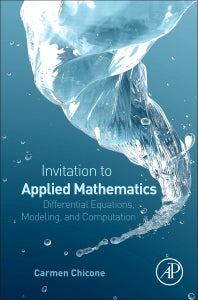Freshly Printed - allow 10 days lead
Couldn't load pickup availability
An Invitation to Applied Mathematics
Differential Equations, Modeling, and Computation
This engaging introduction to the methodology of modern applied mathematics is illustrated throughout with attractive physical problems
Carmen Chicone (Author)
9780128041536, Elsevier Science
Hardback, published 29 September 2016
878 pages
22.9 x 15.1 x 4.3 cm, 1.52 kg
"This is a well-written text, but not an especially easy one. For one thing, the assumed background on the part of the reader is substantial. Although the book expects a lot from a reader, it repays that investment of time and effort in several ways. The author’s writing conveys an enthusiasm for the subject matter that students will likely enjoy. There is a lot of interesting mathematics here, and Chicone has made a serious effort to keep the text as accessible as possible, though I think that his statement that it is suitable for undergraduates may be overly optimistic." --The Mathematical Gazette "This is fantastic resource for anyone who is looking for a single volume that extensively covers differential equations arising from diverse phenomena in physics, biology, chemistry, and engineering. The book is suitable not only as a textbook, but also as an indispensable resource for anyone interested in applied mathematics where differential equations and related numerics make up the core." --Mathematical Association of America
An Invitation to Applied Mathematics: Differential Equations, Modeling, and Computation introduces the reader to the methodology of modern applied mathematics in modeling, analysis, and scientific computing with emphasis on the use of ordinary and partial differential equations. Each topic is introduced with an attractive physical problem, where a mathematical model is constructed using physical and constitutive laws arising from the conservation of mass, conservation of momentum, or Maxwell's electrodynamics. Relevant mathematical analysis (which might employ vector calculus, Fourier series, nonlinear ODEs, bifurcation theory, perturbation theory, potential theory, control theory, or probability theory) or scientific computing (which might include Newton's method, the method of lines, finite differences, finite elements, finite volumes, boundary elements, projection methods, smoothed particle hydrodynamics, or Lagrangian methods) is developed in context and used to make physically significant predictions. The target audience is advanced undergraduates (who have at least a working knowledge of vector calculus and linear ordinary differential equations) or beginning graduate students. Readers will gain a solid and exciting introduction to modeling, mathematical analysis, and computation that provides the key ideas and skills needed to enter the wider world of modern applied mathematics.
Chapter 1: Applied Mathematics and Mathematical Modeling Chapter 2: Differential Equations Part I: Conservation of Mass: Biology, Chemistry, Physics, and Engineering Chapter 3: An Environmental Pollutant Chapter 4: Acid Dissociation, Buffering, Titration, and Oscillation Chapter 5: Reaction, Diffusion, and Convection Chapter 6: Excitable Media: Transport of Electrical Signals on Neurons Chapter 7: Splitting Methods Chapter 8: Feedback Control Chapter 9: Random Walks and Diffusion Chapter 10: Problems and Projects: Concentration Gradients, Convection, Chemotaxis, Cruise Control, Constrained Control, Pearson’s Random Walk, Molecular Dynamics, Pattern Formation Part II: Newton’s Second Law: Fluids and Elastic Solids Chapter 11: Equations of Fluid Motion Chapter 12: Flow in a Pipe Chapter 13: Eulerian Flow Chapter 14: Equations of Motion in Moving Coordinate Systems Chapter 15: Water Waves Chapter 16: Numerical Methods for Computational Fluid Dynamics Chapter 17: Channel Flow Chapter 18: Elasticity: Basic Theory and Equations of Motion Chapter 19: Problems and Projects: Rods, Plates, Panel Flutter, Beams, Convection-Diffusion in Tunnels, Gravitational Potential of a Galaxy, Taylor Dispersion, Cavity Flow, Drag, Low and High Reynolds Number Flows, Free-Surface Flow, Channel Flow Part III: Electromagnetism: Maxwell’s Laws and Transmission Lines Chapter 20: Classical Electromagnetism Chapter 21: Transverse Electromagnetic (TEM) Mode Chapter 22: Transmission Lines Chapter 23: Problems and Projects: Waveguides, Lord Kelvin’s Model
Subject Areas: Applied mathematics [PBW]


